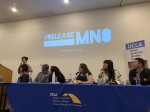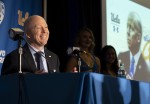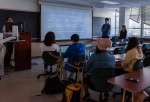A hooded, robelike jacket made out of a KISS T-shirt made its debut among other student fashion lines Thursday night.
The collection was one of 14 student fashion lines displayed on the catwalk at the 18th annual Fashion and Student Trends runway show in Pauley Pavilion. Since UCLA does not offer a fashion design major or minor, the show offers a platform for students to express their passion for design, said FAST President Katie Kim, a fourth-year communication student.
Ellie Tsang, a second-year psychobiology student who attended the fashion show, said she appreciated how it displayed UCLA’s diverse student body and the designers’ different inspirations for their lines.
“It’s pretty interesting to see how diverse our students here at UCLA are,” Tsang said. “You have different styles and different cultures and different causes.”
The show opened with models debuting the line “Free Spirit Collection” by Mariama Bah, a fourth-year anthropology student, who was inspired by street-style summer wear. A women’s strapless white pant jumpsuit was the first piece of the night, followed by a men’s loose satin shirt paired with ripped light-wash jeans. The satin fabric, which highlighted an intricate blue pattern, was apparent throughout the line’s menswear and on a women’s slip dress. Bah’s women’s jumpsuits, two-piece sets and dresses featured rich reds, dark greens and deep blues.
Later in the show, “The Garden of Eden,” designed by first-year physics student Anna Tsai, featured flowers and gold accessories. Her line embodied a natural theme and was inspired by the white camellias that bloom in the backyard of her home. She used cream and white fabrics, along with colored flowers fastened to dresses, draped around models’ arms and woven into flower crowns. Layla Morsi, a first-year psychology student who attended the show, said she liked Tsai’s collection because of its elegance.
Hope Pham, a second-year political science and psychology student, sported a dress of her own design toward the end of the show. The final design in her line, “PHASE,” was a navy evening dress accented by a long train of bright red fabric with a flame-shaped gold applique trim. Her collection also featured a textured gold two-piece set with an asymmetrical satin necktie scarf and a layered skirt. Her next outfit was a pleated white dress with navy trim and thin gold stripes.
While lines such as “The Garden of Eden” and “PHASE” used neutral tones, other lines drew on brighter hues. Third-year design media arts student Madux Middaugh’s line “XXX SS3019” featured graphic design and vibrant colors, such as neon yellow. A few of his styles contrasted with a white jean material dyed with pastel colors that was used in two outfits. Middaugh also refashioned the black KISS T-shirt, pairing it with multicolor painted jeans.
Middaugh’s line was designed to bring light to the fashion industry’s ecological impact. Tsang said Middaugh’s piece composed of Trader Joe’s and Ralphs brown bags stood out to her. She said she also appreciated other designers’ contrasting styles, such as those in “Curvy in Color,” designed by third-year neuroscience and human biology and society student Caliope Marin and fourth-year molecular, cell and developmental biology student Risachi Ogan. Marin, Ogan and Middaugh used their fashion lines to comment on social issues, including ethical fashion and representation of different cultures and body shapes in modeling.
“I really like the contrast (of ‘Curvy in Color’). I like the bright colors,” Tsang said. “I see how (the line) targets issues going on in society today.”






